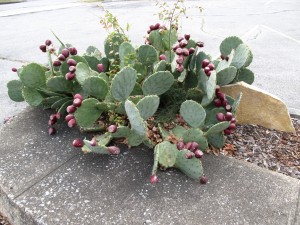There are over 200 species of prickly pear cactus (Opuntia spp.) worldwide. Several make great container plants in the garden or inside the home. Prickly pear cacti may grow to heights of 10 feet or more in the arid regions of the Southwestern U.S.
Eastern prickly pear (Opuntia compressa var. ‘humifusa’) grows 12- 18 inches tall and 30-36 inches wide. It will grow a bit larger in a warm moist habitat. The reddish “pear” fruits ripen in the fall. They taste like kiwi fruits and can be made into jam and jelly. The 3-4 inch wide bright yellow cactus flowers bloom in early summer in the Southern Appalachian region (USDA zones 6 and 7).
Prickly pears need a well-drained soil, preferably sandy or gravely, and they’re planted in full sun. Irrigation and fertilizing are rarely needed. Overwatering causes pads to collapse and the root system to rot. Cacti plants may appear wilted after a cold winter, but perk up and become fully turgid by early spring.
They are easily propagated from pad sections directly into the garden or a container. Allow the cut end to air dry (heal over) for 5-7 days before setting, cut end down, to a 2-inch depth into garden or potting soil. Moisten the soil after planting and no further watering is needed. Pad(s) generally root in 4-6 weeks.
Prickly pear spines greet you with hostility. Wear thick heavy duty gloves to protect yourself from the large smooth spines and small, hair-like needle spines over the pads.


 Posted in
Posted in 
